
Title means "Quietness", "Comfortable Sound" and "Excellent Acoustics"
Nagata Acoustics News 02-5 (No.173)
Issued : May 25, 2002
AV Systems for McCann-Erickson Japan Corporate Headquarters
by Makoto Ino
Entrance
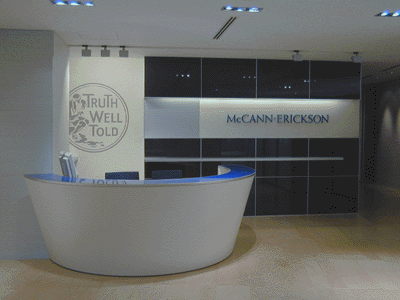 |
McCann-Erickson Japan, Inc. hired Nagata Acoustics as audio-visual ("AV") system consultant for the design and construction of new AV facilities at its Tokyo headquarters. McCann-Erickson Japan belongs to the global advertising agency network McCann-Erickson Worldwide Advertising, which operates in 131 countries around the world. The Tokyo headquarters are located in Shin Aoyama Building, the eastern tower of the Aoyama Twin Tower complex, a prime real estate location near both the Aoyama 1-chome subway stop and the trendy Roppongi section of Tokyo. The design and installation of new AV facilities upgrades all of the firm's conference rooms in its headquarters conference room zone, on the tower's 22nd floor. The work is part of a larger project plan, now in progress, to renovate the entire McCann-Erickson Japan Aoyama Headquarters.
<< Roles, Players and Process for the AV Project >>
System-O Design Associates, led by company Principal Ty Lee, has overall management responsibility for the headquarters renovation project. Nagata Acoustics began work on the conceptual design of the AV system in June 2001. Thereafter, our responsibilities included creation of the schematic drawings, the design development and production of the construction documents, as well as management of the construction implementation. We completed turnover to the client in March 2002. Kowa Co., Ltd. performed the construction implementation of the conference room AV systems.
In the following paragraphs, I will focus on the AV system we designed for McCann-Erickson's two largest conference rooms. (The designs for these two conference rooms were very similar.)
<< Recent Trends in Conference Room AV Design >>
Presentation room
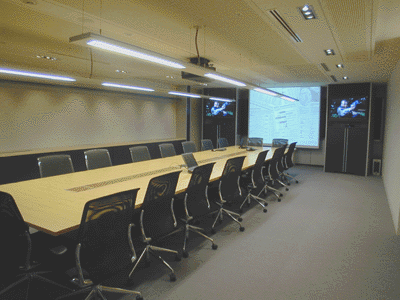 |
Conference room AV systems comprise all of the equipment and devices installed in a conference room to facilitate and support communication, presentations, lectures, and other sharing of information through the human faculties of hearing and sight. In the past, conference visual materials typically meant printed materials distributed to each attendee. However, with the nearly universal adoption of video projectors by the business community, the norm at conferences today is to attach a projector to a laptop computer and project images of both text and graphic material onto a large screen for common viewing. Likewise, while overhead projectors were prevalent just a few years ago, they are quickly being replaced by digital document cameras (DDCs).
As companies expand the geographic reach of their businesses, the use of videoconferencing also increases. For organizations such as McCann-Erickson that have broad international and global operations, videoconferencing capability is considered a necessity. Videoconferencing systems use combined voice-and-data technologies developed by telecommunications carriers to simultaneously transmit video signaling, computer files, online input activity, visuals captured by DDCs, and other digitized data together with real-time, bi-directional sound transmission. Multiple visual-format transmissions can be simultaneously viewed in split-screen or other layouts on a single large conference room screen or multiple TV monitors can be placed in a conference room with each one receiving the feed for a single video or other multimedia transmission.
<< The Enhanced Visual and Sound System >>
Even before Nagata Acoustics began our discussions with McCann-Erickson, we could foresee that our client's expectations would be the design and installation of a state-of-the-art AV system with the kinds of high-tech components and capabilities described above. In addition to these somewhat generic requirements, the firm set forth the additional and more challenging requirement that it be able to use the conference rooms' AV systems for showings of TV commercials and for screenings of other multimedia products it creates for its clients. This stipulation raised the bar for the kind of AV system required, because the AV quality of TV-technology transmissions exceeds the quality typically considered satisfactory for projecting still images, text and graphics produced using limited color combinations.
For client viewers to fully appreciate a TV commercial or a promotional video or film, the conditions need to be more like a movie theater than a conference room. Qualities such as naturalness and aesthetics cannot be overlooked or underplayed, and the performance level of the equipment used must consistently deliver the true impact that each production's creative team intends to convey.
Moreover, the sound quality must be in balance with the enhanced visual capabilities of the AV system. The sound system must have robust power and create a sense of presence. In particular, since in the next few years, more and more TV networks will implement over-the-air high definition digital TV, with its 5.1 channel surround sound, Nagata Acoustics took these future developments into consideration in the sound system of our AV design. In addition to installing a ceiling speaker for speech reproduction, we also installed separate main speakers and surround-sound speakers as well.
<< The AV System's Display Devices >>
Screen layout
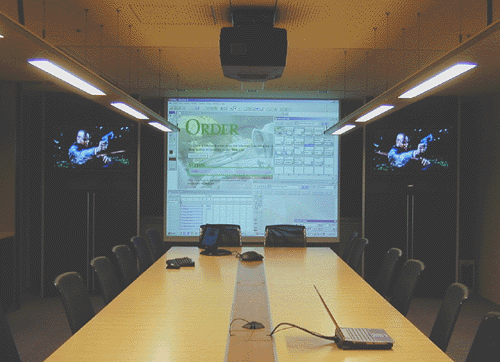 |
The most important pieces of equipment in an AV system are its display devices. For the McCann-Erickson project, our basic approach was to install a 110-inch screen for the projection of computerized data and presentations, document camera images and videoconferences, and a 42-inch plasma display panel (PDP) for TV-commercial presentations.
Corporate meeting participants often want to take notes or refer to printed materials at the same time that they are viewing an on-screen presentation. Therefore, conference rooms need to provide some ambient light even while showing videos and TV-commercials. Because ambient light negatively impacts the visible contrast of projected images, one of the requirements we set for the room's video projector was that it have high lumen output so that its brightness would overcome the ambient light conditions.
In our original design plan, we proposed a digital light processing (DLP) projector because these projectors provide excellent resolution and brightness. However, in the wake of the September terrorist attacks in New York and the ensuing downturn in the economy, we were forced to cut this project's budget by more than half, and one way we economized was by selecting an LCD projector instead. LCD projectors do not project cinematic material as well as DLP projectors do, but we made the best possible choice among the LCD projector options by trialing each of them and doing first-hand comparisons. After the completion of the McCann-Erickson project, we viewed the quality of the LCD projector in the client's conference room and acknowledged that for DVD and other cinematic-like moving images the ambient light in the conference room needed to be made very low in order to achieve sufficient contrast on the viewing screen. However, for the projection of computerized files and slides, the LCD projection was fine and there is no difficulty at all in viewing projected text and still images.
Plasma display panels offer excellent contrast and color balance even in the bright ambient light of a room that has a window and the blinds open in daytime conditions. These panels also display computer files and slides satisfactorily. If the price of PDPs becomes more affordable, there is a strong likelihood that they will find wide appeal among consumers as well as businesses.
<< The Conference Room's Integrated Control System >>
Touch panel
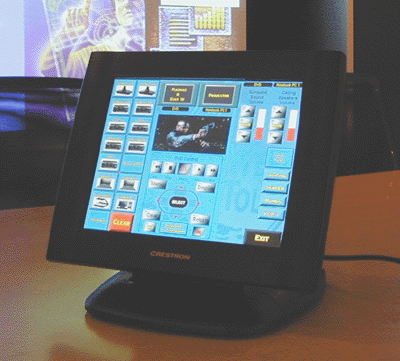 |
Each of McCann-Erickson's two largest conference rooms boast the full array of input devices, including VHS, 3/4-inch U-matic and Betacam VCRs, a DVD/CD player, cassette tape deck, digital document camera, desktop computer, two laptops, the videoconferencing equipment and an auxiliary input. The output devices are also numerous and include not only the large video screen and two PDPs, but also a TV monitor and a video recorder. With such an extensive choice of input and output devices, we recognized the need to avoid user confusion when connecting and operating the various devices. To this end, we installed an integrated control system. All of the connections and the operation of the devices is consolidated in a single, large touch-screen. This approach to making AV system operation user-friendly is already common in the U.S. and Europe. In implementing an integrated control system, it is important to remember that its ease of use depends on the customization of a software program. Therefore, the details of an integrated control system's operation should be determined through an iterative process based on actual use.
<< In Conclusion: A Word of Thanks >>
Throughout this project, Mr. Max Gosling, President and CEO of McCann-Erickson Japan, and everyone with whom we worked showed their strong understanding of the role and value of the AV system consultant. They trusted our competency and allowed us to make decisions and move the project forward without micromanaging aspects of the project that were our responsibility. For this, we are deeply grateful.
Kitakata Plaza's Volunteer Stagehand Org. Nears Age 20
by Motoo Komoda
<< Overview of Kitakata Plaza >>
Main Hall
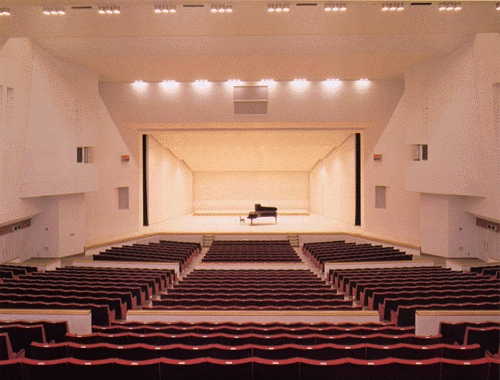 |
Kitakata Plaza is a regional cultural center constructed in Kitakata City, Fukushima Prefecture. Its facilities include a main hall that seats 1,200 persons and a small hall with removable seating that seats an audience of up to 400, as well as meeting rooms and an office for the center's staff. The center opened in November 1983. The facility is managed and operated by the Greater Kitakata Region City and Townships Association, which relies on a mere six permanent employees to take care of the center's needs and activities.
Despite its small number of paid personnel, the center's doors are open every day of the year (except for a few days' recess at New Year's.) The center plays a significant role as a primary location and gathering place for the entire region's cultural activities. For example, during the nearly 20 years since the center opened, more than 2.4 million people have used its facilities. The main hall maintains a usage ratio greater than 50% and the small hall's usage exceeds 80% annually. The center offers a strong menu of programming to residents of surrounding communities and Kitakata Plaza's efforts to bring quality performers to its stages have earned it the attention of Japan's cultural and entertainment commentators. In 1994, Nagata Acoustics featured the center's Director, Mr. Takao Usuki, as well as the center's other local supporters in an article about its successful programming.
<< The Volunteer Power Behind Kitakata Plaza's Success >>
Kitakata Plaza's volunteer organization's name is "Urakata," the Japanese word for "stagehands." As the organization's name implies, these volunteer local residents perform a wide range of backstage tasks and services. Urakata was organized just four months before the center opened. At the time, most of the several dozen individuals who originally volunteered for Urakata had no background in the stage work ahead of them. But through a time-crunched and intensive period of study and practice, they managed to successfully provide Kitakata Plaza with all of the backstage services and support it needed for its inaugural ceremonies and performances on opening day. In foreseeing the need for this corps of volunteers, organizing and training them, Mr. Usuki and the center's other employees certainly added a huge task to their duties at a time when their own workloads were heaviest. These days, new halls also may decide to rely on volunteers as stagehands, but they have precedents to use as a guide. When Kitakata Plaza implemented its Urakata organization, it pioneered a new approach to hall staffing.
<< Evolution of the Volunteer Stage Crew's Organization >>
Nearly 20 years after Kitakata Plaza's opening, Urakata volunteers continue to support the center by making themselves available for stagehand tasks, by operating and overseeing the maintenance of stage equipment and in many other ways. Over time, Urakata developed contacts with other halls' volunteer organizations. As these contacts strengthened, volunteers of different halls began attending the performances where other volunteers worked behind the scenes. They also help each other's organizations by lending them equipment and even working as stagehands at each other's halls. Today, the informal contacts have grown into a nationwide network named the Japan Stage-study Networking Association. Its members hold an annual, Japan-wide get-together and maintain their own website where they share information about up-coming performances.
<< Kitakata Plaza's Multiple Sources of Funding and Programs >>
Kitakata Plaza's annual budget is approximately 100 million yen (US$763,000), surely not a lavish sum of money. However, a significant number of regional and other outside organizations participate in financially supporting the center's activities and programming. One of these organizations, the Independent Cultural Promotion Association, sponsors some 15 events annually at Kitakata Plaza and other regional facilities. This association is officially chaired by the chairman of the Greater Kitakata Region City and Townships Association (and both chairmanships are actually held by the mayor), but a committee of business people and the directors of all of the region's cultural facilities decides what programs and events the Cultural Promotion Association will sponsor.
In addition to support provided by the semi-governmental Cultural Promotion Association, other organizations also develop and support events held at Kitakata Plaza. These organizations include: the Kitakata Music Appreciation Society+ADs- Kitakata Children's Theater: Kitakata Drama Society; the region-wide Theater Production Committee; and, the amateur event-production group "Friends."
At the professional level, the Kaze-no-ko Tohoku Theater has a franchise contract to use Kitakata Plaza for its performances. Also, as a further financial buttress, Kitakata Plaza Patron's Organization formed in 1997. This organization's primary purpose is fundraising to support Kitakata Plaza.
<< Audience-focused Programs and Community-participation Programs >>
In Kitakata Plaza's 2001 annual event sponsorship plan, the center classifies all of its supported events and programs into one of two categories. The first category is events and programs that will extend the reach and roots of cultural activities throughout the region by sharing information about events and programs and through grass-roots regional cooperation so that the region's cultural activities can develop a consolidated base. The second category of events and programs come from proposals specifically developed by the center to further promote both cultural activities that local residents attend and cultural activities created and performed by the community.
For as long as Kitakata Plaza has been in operation, the center has paid attention to encouraging the center's use for"creating"as well as"being a spectator" of culture and the arts and, as a result, it never needs to worry about lapsing into periods of ghost-town-like disuse. For example, the center annually sponsors a performance by a group known as NLC (an acronym for New Life Circle), most of whose members are teachers from the regions' schools. NLC structured its early event planning as programs of consecutive solo musical performances. Recently, however, the group successfully challenged itself to perform a full-scale production of"The Marriage of Figaro,"and NLC now intends to do the long-term planning required to develop other major productions.
<< Annual Acoustical Engineers Conference at Kitakata Plaza >>
In 2002, Kitakata Plaza also hosted the 14th conference of acoustical engineers known as FBSR. (The conference's name is an acronym that combines references to "Feed Back," as in the feedback provided to performers and the manufacturers of audio equipment,"Fine Business," another aim of Japan's acoustical engineers, and "Sound Reinforcement," one of FBSR's focus topics.) FBSR meets on an almost annual basis, and for the past several years, Kitakata Plaza has included hosting the conference among its scheduled, center-supported events.
The 2002 FBSR conference
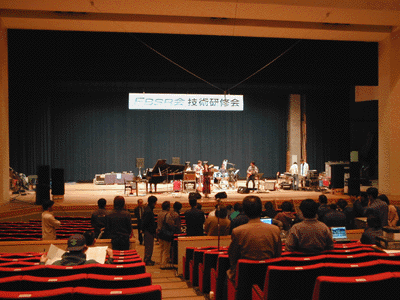 |
This writer attended the 2002 conference, which was dedicated to digital mixing and included live demonstrations of the latest digital mixing consoles as well as tutorials on their use. The 2002 FBSR conference was a large-scale event that made use of Kitakata Plaza's main hall, small hall, dressing rooms and open space areas. In the main hall, a live band performed into a microphone and each participating manufacturer had the opportunity to demonstrate its equipment using the same music. Feeds were also extended to the small hall and other rooms, where additional mixing devices could be heard and trialed.
<< Challenges Kitakata Plaza and its Urakata Face Today >>
Amidst its many successes, Kitakata Plaza also faces a number of challenges, some of which stem from its reliance on volunteers as its stage crew. The number one problem is that there are not enough Urakata members and, in particular, there is a growing imbalance in the average age of the volunteers. When Urakata was established, the first generation of members were mostly young adults in their twenties, but Urakata finds it increasingly difficult to woo new, young recruits.
The center's reliance on volunteers also causes another problem. Fundamentally, the volunteers are amateurs, and therefore, they are more likely to be accepting of imperfectly performed tasks or mistakes. As a result, when performers or event producers bring professional stage crews to the center, tensions arise between the Urakata volunteers and the stage professionals.
In addition, should Kitakata Plaza need to consider decreasing its level of self-sponsored programming, the work done by Urakata's members would lose its connection to the center and become simply donated labor. The volunteers' motivation would diminish, and eventually the system would no longer be able to be sustained. This possibility is just one more challenge among a long list of concerns that the Urakata volunteers expect they will need to address in the future.
To find solutions to the kinds of issues faced by Urakata, Kitakata Plaza's management should bring together both professionals and amateurs to share their experience and expertise in open discussion, with a level playing field as the ground rule for all sides. In addition to creating forums for discussion through the town-hall-style meetings of the past, new methods such as the use of online Internet discussion should also be tried. The goal here would not be to develop a standardized operations manual or single solution for all situations, but to learn to acknowledge the special characteristics and requirements of different kinds of performances and stage technologies. Then, as everyone involved gained awareness in how to appropriately harness each other's strengths, I think that even the discussion process would be seen to have value.
For more information on Kitakata Plaza, please visit its website (in Japanese only) at www.kitakataplaza.jp/ or contact the hall directly by telephone: 241-24-4611, fax: 241-24-4612, or mail: Aza Oshikiri 2-1, Kitakata City, Fukushima Pref. 966-0094.
E-mail Distribution of Nagata Acoustics News & Opinions
We hope you have enjoyed this News & Opinions newsletter, available each month on our web-site (http://www.nagata.co.jp). We also offer e-mail delivery of the text version of this newsletter. To receive the text newsletter to your e-mail address, simply send the following information to us at "newsmail_e@nagata.co.jp"
(1) Your e-mail address
(2) Your name
(3) The name of your company
By requesting the text version via e-mail, you will automatically receive every newsletter and you can still get the visuals and graphics at our web-site.
Nagata Acoustics News 02-5(No.173)
Issued : May 25, 2002
Nagata Acoustics Inc.
Hongo Segawa Bldg. 3F, 2-35-10
Hongo, Bunkyo-ku, Tokyo 113-0033 Japan
Tel: +81-3-5800-2671, Fax: +81-3-5800-2672
E-mail: info@nagata.co.jp








